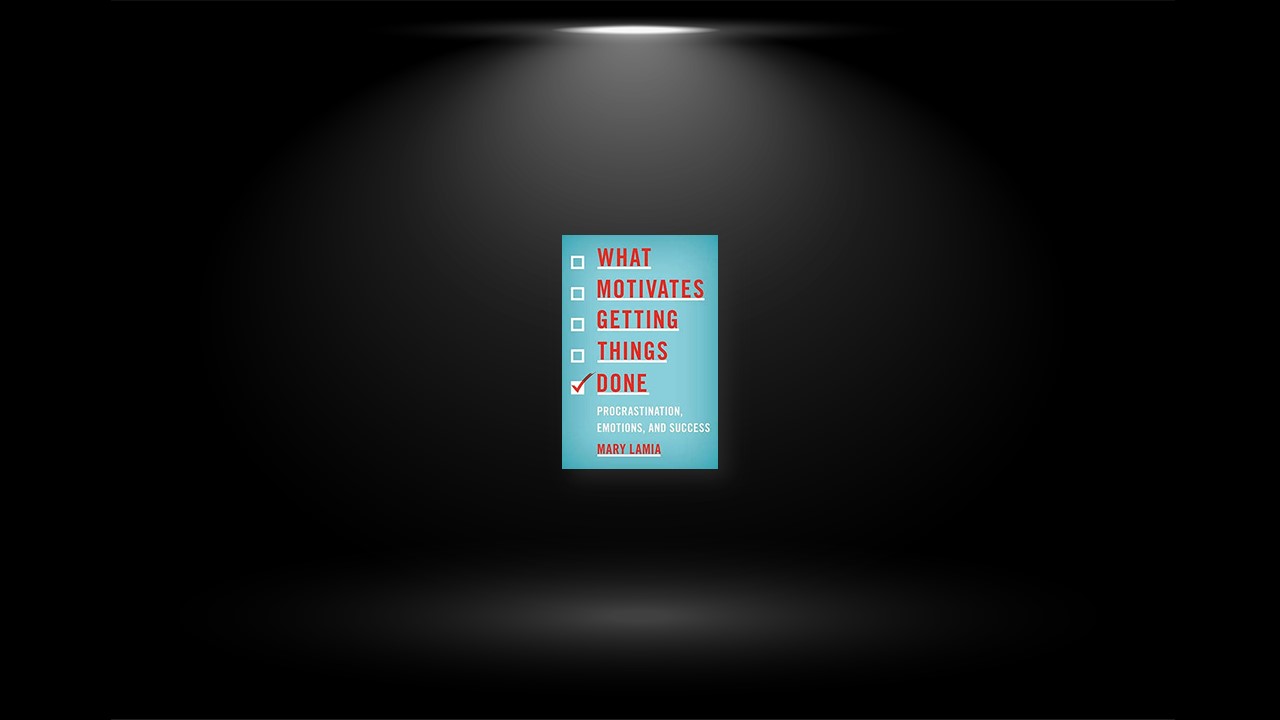What Motivates Early Action or Delay?
What motivates you to get something done? Simply put, both positive and negative emotions are designed to help you focus your attention on whatever activates them. When a biologically based emotion enters your consciousness, cognition is its travel companion. Often, people confuse emotion (feeling) with cognition (thinking) because these processes arise together.
Our cognitive system makes specific the information provided by emotion. That is, when an emotion is activated, the meaning you automatically attribute to it—what you think along with the emotion or in response to it—will focus the vague information that is provided by what you feel.
Motivation Basics
Emotions are a powerful and efficient motivational system. Biologically, emotions are immediate and reflexive. Their activation occurs in response to a specific stimulus—a situation, an event, an image, or a thought—of which you may or may not be aware. Your brain has the ability to evaluate circumstances in the environment. If it comes across something it wants to amplify, it can, through emotion, effectively draw your conscious attention to that stimulus by making it important positively, negatively, or neutrally.
When your brain activates an emotion, the various components of your nervous system create physiological and sensory changes in your body and coordinate emotional expression. The thoughts accompanying an emotion are images created by your cognitive system, as well as subsystems of perception, motor control, memory, and language that make more specific what the emotion conveys. Thus, in a general way, emotions help you to recognize or adapt to opportunities or problems and what’s going on around you.
Any emotion, positive or negative, can motivate you to complete a task. You may be motivated to do something because it activates the pleasurable feelings that accompany positive emotions. On the other hand, you may be motivated to do something to avoid the feelings that may result from negative emotions or to relieve yourself from feeling their effects. This is one of the ways in which human beings are wonderfully designed: we are motivated to maximize our positive emotions and minimize negative ones.
Now, this does not mean we are a bunch of hedonistic pleasure seekers. Although we are built to desire good feelings, we are also equipped with emotions that can impede or disrupt our positive feeling states. You may have noticed that emotions such as shame, guilt, or disgust do a very fine job of interfering in situations when you might be feeling really good, such as when you’ve eaten a delicious meal but have eaten too much. We may not like feeling some of our negative emotions, but they serve an important purpose
Our avoidance of negative emotions or our wish for relief from how they make us feel not only motivates us but also keeps us in check both personally and socially. If nothing ever got in the way of our pleasure seeking, we would not have a civilization that functions very well, and we may not be mindful of imposing limits on ourselves. It’s not the fault of evolution that some people do things that do not maintain the social order. Perhaps we can view such behavior as an evolutionary function gone awry.
The Activation of Emotion
An emotion will be activated when it is triggered by a stimulus—an event, a situation, a thing, or the action of another person. It’s common vernacular these days to claim something has “triggered” you, implying something has happened that has messed you up emotionally because it has activated an emotion based on an unpleasant emotional memory.
This notion is not far afield from what actually happens, but at a more basic level what activates an emotion can be any stimulus. The emotion directs your attention to the stimulus that activated it, whether or not you like it. One typical stimulus that would activate an emotion, for example, is the siren of an approaching emergency vehicle. As the sound becomes closer and louder, your heart begins to beat faster, and you may have an urge to look outside to see what’s going on. You cared (paid attention) because you felt something. Feelings make you care. Be it mild fear, distress, or interest, the stimulus motivated you to take an action. Perhaps what you felt led you to protect or reassure yourself, or maybe you were led to satisfy your curiosity.
Similarly, a task to complete is also a stimulus, whether it’s a presentation to prepare for or an overflowing toilet to unclog. Some stimuli, like an overflowing toilet, generally create a sense of urgency for most of us, whereas other stimuli can more easily be disregarded.
Biased Attention and the Formation of Scripts
What attracts our attention—our preferential perception—is based on the relative emotional importance of a stimulus. Theorists refer to this process as affect-biased attention.
The potential for emotions to bias attention has been studied in phobias, for example, where people who are fearful in certain situations are more inclined to direct their attention to stimuli in the environment that mimic those fears.
Thus, if you are afraid of encountering a coyote during your hike on a trail, you may be more likely to mistake another hiker’s dog in the foliage for a coyote than someone who has not developed such a fear. Our attention is biased in numerous ways as a result of our experiences of emotions that were activated, or not activated, by a particular stimulus. Whereas one person, for example, may have an emotional response that always makes him or her pay attention to dirty dishes in the sink and feel compelled to do something about them, another person may not notice.
Consequently, such differences are often a source of interpersonal conflict. We may not take into consideration the fact that people differ on the basis of their preferential perceptions and may instead misunderstand or ridicule their behaviors or habits.
Thinking and Feeling
When an emotion makes a stimulus important by magnifying it, that importance is transformed and held in place by cognitions—the thoughts you assign to it. So if fear is activated when you hear the siren of an approaching emergency vehicle, it will garner your attention. Concurrently, you will likely have an image or thought about where it is headed and what has happened. Your emotions placed the stimulus of a siren prominently in the arena of your attention by magnifying it and providing you with general information and motivation to do something. At the same time, your cognitive system makes the general information specific, in this case, speculating where the vehicle is going and why.
In consciousness, feeling and thinking always arise together so when you hear the siren of an approaching emergency vehicle or become aware of a task to complete, for example, your thoughts and feelings will emerge simultaneously. Cognitions that arise along with an emotion are necessary to make that information more specific.
Of course, in many cases, an emotion will amplify how you feel about something, but what you think alongside of it is usually complete conjecture on your part. In a sense, what you think about something you may fear doesn’t tell you what you are actually afraid of but instead provides the best information your mind has available to it. For example, you may be fearful whenever you drive across a bridge. Your cognitive response may lead you to believe that driving over a bridge is dangerous, when in fact, you are unaware of what you actually fear. However, if you believe you fear the bridge, then your fear may be triggered on subsequent trips.
Evaluating Situations and Taking Action
Your brain’s ability to evaluate situations, events, or stimuli is referred to as an appraisal or an appraisal tendency. Such appraisals happen automatically, without your conscious control, and trigger a reflexive emotional response.
Your appraisal system takes into account your well-being, plans, and goals when it processes events or situations and provides them with meaning. Your brain scans this incoming sensory information to detect patterns associated with past situations, even before you recognize what may be happening.
Thus, memory is an important contributor to our emotional responses to situations, and as such, we appraise events, both consciously and unconsciously, based on how closely the circumstance resembles past situations and patterns. As a result, certain situations will always evoke past memories, and these appraisal tendencies are the characteristic way in which your brain has learned to evaluate them. In other words, emotional responses involve both your biology and the biographical memories that amplify what you feel.
For instance, if you had an intensely shaming experience in fifth grade when you raised your hand to make a comment, this experience will forever remain in your emotional memory and may color your feelings every time you command center stage to provide an opinion. Even so, present experiences that differ from those in memory, such as having subsequent positive moments in the spotlight, can dampen the future impact of unpleasant emotional experiences.
Motivation Provided by Positive Emotion
There is a positive emotion namely, interest-excitement. Interest, and its more intensely felt presentation in excitement, is activated when your brain evaluates a situation or event with pleasantness, desire, or a perceived need to expend effort. Curiosity, exploration, and information seeking are associated with the emotion of interest, which has high value in terms of learning, which takes place throughout the human life cycle.
In fact, researchers found that people who use strategies to make an activity more interesting (i.e., self-stimulation) tend to view the activity more positively. Although interest and enjoyment are helpful innate tools we use for task completion, the motivation we derive from avoiding negative emotions or seeking relief from them is an engine that can really drive us
To summarize, our motivation to do something, whether immediately or at a deadline, is based on what will maximize our positive emotions or diminish or relieve our negative emotions. Positive emotions supply us with energy and drive. Experiencing a positive emotion about anything will direct our attention toward it, whether it’s something that has to be done or an activity that distracts us from a task.
When a project or a deadline for a project activates a negative emotion and amplifies the urgency to complete it, we may be motivated to get it done so that we’ll be relieved. Similarly, the way in which we respond when an emotion is activated also determines why we may get things done ahead of time or wait until a deadline.
Finally, any emotional response in the present is influenced by our history, culture, and implicit memories of prior experiences when that emotion was activated. Now that we’ve covered some basics of emotion as a motivating force, let’s take a look in the next chapter at the powerful role of anxiety in motivating task completion.


